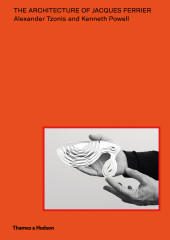 Neuerscheinungen 2016Stand: 2020-02-01 |
Schnellsuche
ISBN/Stichwort/Autor
|
Herderstraße 10
10625 Berlin
Tel.: 030 315 714 16
Fax 030 315 714 14
info@buchspektrum.de |

Kenneth Powell, Alexander Tzonis
(Beteiligte)
The Architecture of Jacques Ferrier
2016. 256 S. colour and b&w ill. 320 mm
Verlag/Jahr: THAMES & HUDSON 2016
ISBN: 0-500-34312-8 (0500343128)
Neue ISBN: 978-0-500-34312-8 (9780500343128)
Preis und Lieferzeit: Bitte klicken
It was perhaps no surprise that Jacques Ferrier was personally selected by French President Nicolas Sarkozy to design the countrys pavilion for the Shanghai World Expo in 2010. It was to become, along with Thomas Heatherwicks Seed Cathedral, one of the most lauded and visited pavilions of the fair, and embodied the key characteristics of Ferriers work: a deep interest in technology; the encouragement of social interaction through the use of courtyards, walkways and loggias; and the use of a perforated outer skin that not only responds to the need for internal climatic control but also provides an additional space for informal social gathering while softening the transition from the buildings internal space to the outside world. Influenced by the critic Rayner Banham, by the work of French architect-engineer Jean Prouvé, and by his early experience of working with Norman Foster, Jacques Ferrier has developed a highly individual approach to architecture that seeks to harness technology in order to create buildings and urban environments that fully engage with the practical and emotional needs of people. Central to Ferriers philosophy is the idea of the Sensual City, which aims to create buildings and cities that engage with the five senses - sound, smell, sight, touch and taste - that are central to human experience. Ferrier is the antithesis of the celebrity starchitect, but his work stands out precisely because of its calm thoughtfulness, sensitivity and precision.
It was perhaps no surprise that Jacques Ferrier was personally selected by French President Nicolas Sarkozy to design the countrys pavilion for the Shanghai World Expo in 2010. It was to become, along with Thomas Heatherwicks Seed Cathedral, one of the most lauded and visited pavilions of the fair, and embodied the key characteristics of Ferriers work: a deep interest in technology; the encouragement of social interaction through the use of courtyards, walkways and loggias; and the use of a perforated outer skin that not only responds to the need for internal climatic control but also provides an additional space for informal social gathering while softening the transition from the buildings internal space to the outside world. Influenced by the critic Rayner Banham, by the work of French architectengineer Jean Prouvé, and by his early experience of working with Norman Foster, Jacques Ferrier has developed a highly individual approach to architecture that seeks to harness technology in order to create buildings and urban environments that fully engage with the practical and emotional needs of people. Central to Ferriers philosophy is the idea of the Sensual City, which aims to create buildings and cities that engage with the five senses sound, smell, sight, touch and taste that are central to human experience. Ferrier is the antithesis of the celebrity starchitect, but his work stands out precisely because of its calm thoughtfulness, sensitivity and precision.
Kenneth Powell arbeitet als Architekturkritiker in London. Er hat mehrere Bücher veröffentlicht, u.a. Monographien über Richard Rogers und Norman Forster. Er ist freier Mitarbeiter von Architekturzeitschriften, Magazinen und Zeitungen in England. Er war Berater von Architectural Design und von 1987-1994 Architekturkorrespondent des Daily Telegraph.
Alexander Tzonis studierte in Yale, lehrte 1967 bis 1981 in Harvard und war Gastprofessor u. a. am MIT, an der Columbia University sowie am Collège de France. Er hat einen Lehrstuhl für Architekturtheorie and Designmethoden an der Universität von Delft, Niederlande. Außerdem ist er Direktor von Design Knowledge Systems, einem interdisziplinären Forschungszentrum.


